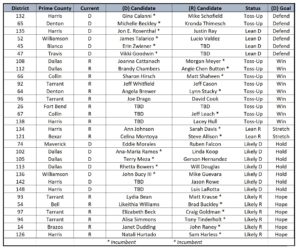It’s time to take an early look at the Texas State House of Representatives.
Democrats have a slight chance to reclaim the Texas House for the first time in 20 years. It’s a VERY long shot at the moment, but it’s worth some premature attention due to the vast importance of that flip both to Texas and to the nation.
The next Texas legislature will redraw the state’s districts for the next decade and a Democratic House could stop the severe gerrymandering that Republicans will impose if they completely control the government. Since a Republican Texas Governor and a Republican Texas Senate are foregone conclusions, the Texas House is the only option for Democrats. Note that districts will be redrawn both for the Texas Legislature and for the Texas seats in the U.S. House. The latter could impact control of the U.S. House through 2030. In short: It’s important.
To retake the Texas House, Democrats need a net gain of 9 seats in November. The Texas Democratic party claims to be targeting 22 seats to flip. An independent Democratic group claims to be targeting 17 seats to flip. On the other side of the aisle, the Republican party claims to be targeting all 12 seats that they lost to Democrats in 2018. All of these targets are delusional. Both parties will need to spend considerable resources just to defend seats they already have. The reality is that Democrats will likely make net gains but will travel a pretty tough road to a possible majority.
As always, I ignore the races that will safely remain in either Democratic or Republican hands, leaving only 30 of 150 races that are even worth following. I list those 30 races by goal categories in order of where Democratic focus (i.e. money) can best be applied. My analysis thus doesn’t necessarily prioritize the “best” candidates; it prioritizes the races that can best produce a Democratic win of the chamber.
At this point, polling data is almost non-existent and many races haven’t even finalized the ballot since run-off primary elections are still TBD. Thus, my early analysis is based on voting data from the 2018 elections and the 2016 Texas Senate race, demographic trends, party attention to the district, and the relative strengths/weaknesses of the known candidates.
Below is a first rough cut at a breakdown of the Texas House races that deserve Democratic focus. <Click on the table to display a larger version.>
Here’s a bit more detail by goal category:
- Defend: Current Democratic seats that Lean D or are Toss Ups
- These six races are defensive. Democrats absolutely need to retain these seats and the races promise to be close. At the moment, the Democrat is slightly favored in four of races; the other two are toss-ups.
- Win: Current Republican seats that are Toss Ups
- These nine races are the best chances for Democratic flips. Democrats need to win every single one of these seats to retake the Texas House. As I said, it’s a VERY long shot. Note that seven of the nine seats are roughly in the DFW metroplex.
- Stretch: Current Republican seats that Lean R
- These two races are stretch goals. Each deserves Democratic attention as a buffer for a possible loss above.
- Hold: Current Democratic seats that are Likely D
- These seven races are defensive. While Democrats should be able to hold them, they aren’t guaranteed. If there’s money left over after focusing on the races above, it should go here.
- Hope: Current Republican seats that are Likely R
- These six races are long shots – and Democrats would need to get very lucky to win any of them. The best they can do is hope.
While my analysis will likely change over time, it seems at the moment that Democrats could barely eke out a 2020 majority in Texas House. While unlikely, it is at least possible. And it’s too important not to try.
